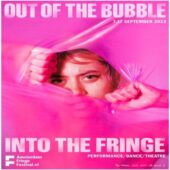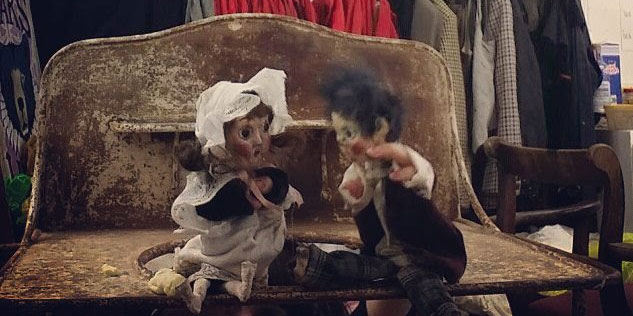SETTING THE STAGE
Initial thoughts following the realisation that the puppet show The Sorrowful Tale of Sleeping Sidney, being a tale of Victorian Brighton, might be best served by puppets that carry a ‘Punch n Judy’ seaside feel, artist and creator Daisy Jordan considered whether the show might actually be performed within the recognizable confines of the red-and-white-striped booth so iconic to the glove-puppet world. 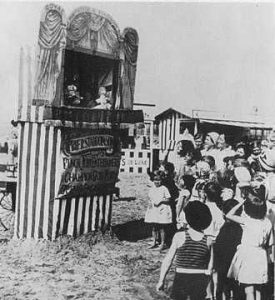
Ultimately this idea was discarded as being both too limiting – the booth is so utterly recognizable with Punch & Judy it is almost a sin to use such a space for anything but a show for those specific characters, and besides, such an idea falls dangerously close to being a gimmick. This show needed to tip a nod to the puppetry of that era, while enabling Daisy the opportunity to appear alongside the puppets. In that way, the show could evolve into something more than a simple retelling within the ‘world’ provided by the framing of the Punch n Judy Booth. That said, the astute eye and quick wit will spot more than a couple of subtle motifs from sagas of Punch to satisfy the correlation.
Given the limitations present with glove puppets – and such lends to their characterful charm – they do generally need something to conceal the puppeteers arms. This typically means various different ‘wall’ devices… unless of course the puppeteer is able to bring their hands up through the floor of the puppets performance space…
At the time Daisy had been working on how she, a performer rather than invisible puppeteer, might be incorporated directly into the show, -and I am making this sound much more sequential than it actually was, the reality of which is of course a massive melange of possibilities and directions to explore. The idea emerged with Daisy imagining herself, the narrator, as maybe some version of Christiana Edmunds, much later in life, regaling her imaginary audience from within a domestic space in which she might reside…
From these two strands of character development and performance space arose an image of an old Victorian wash stand, such that it might evoke a plausible feeling of an object contemporary with the era of the show, but with sufficient versatility to enable puppetry from behind, and more significantly up and through where the washbowl would be located, thereby providing the puppeteer with different, nonlinear locations within which to play.
I don’t know if these things are available all the time – we only ever looked once – but by pure chance or the will of Ms Edmunds to assert her notoriety from beyond the grave, we found one offered for sale via a local online classified-ad service, a meagre few counties away. It stood abandoned in the back of someone’s garden, where the character of oxidation had been granted leisurely leave to add its decadent orange patina to the spindly metal frame. 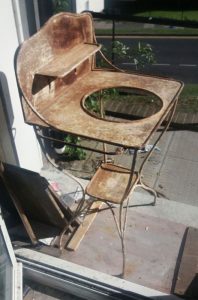 The washstand was purchased for the modest sum of five English Pounds and was brought back to Brighton. That now villainous oxidation proceeded to spread its filth across everything and so a heavy handed abrasive was applied before fresh lick of paint resurrected the grandeur once more.
The washstand was purchased for the modest sum of five English Pounds and was brought back to Brighton. That now villainous oxidation proceeded to spread its filth across everything and so a heavy handed abrasive was applied before fresh lick of paint resurrected the grandeur once more.
However it would not be sufficient for this show – spanning so many parts of Brighton’s geography – to use just a single object, no matter how creatively Daisy’s mind might be applied to such problems. It was thought that perhaps different domestic furniture might be used on stage to clearly demonstrate different locations within the show, with different furniture adding their own personal elements to the puppets world. The wash stand, offering both the shelf behind and the cavity where the wash bowl would be inserted, could double as both street locations and brighton beach maybe?
At some point in the devising, perhaps by happy chance, Daisy sat on a regular old 1970s dining chair, from which to focus on her handiwork. As a narrator wanting to occupy different visual levels it was considered that she might want to sit at certain points and that a chair could be justified on the stage.

For reasons that become apparent in the show – withheld here under the premise of Victorian modesty – Daisy had begun employing a chair from which to narrate parts of the show. The chair on which Daisy sat – a crummy 1970s generic dining chair, almost certainly retrieved from beside a Brighton Bin and used as part of our residential furniture – was standing in until such a time as a ‘proper Victorian crummy dining chair’ might be secured. 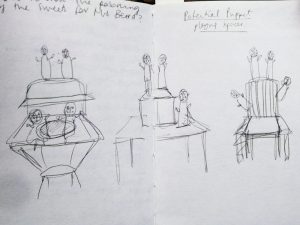 And then that chair became embroiled in various diagrams of the staging until suddenly there it was: one of those simple strokes of genius, and we knew we were committed to that chair and no other: The bars on the chair back were vaguely reminiscent of the bars of a jail cell, and might be just enough to allow us to conjure the workplace of Inspector Gibbs, now of course situated beneath Brighton’s Town Hall. A further modification to the chair would allow this space to transform once again… Brighton Nick was born.
And then that chair became embroiled in various diagrams of the staging until suddenly there it was: one of those simple strokes of genius, and we knew we were committed to that chair and no other: The bars on the chair back were vaguely reminiscent of the bars of a jail cell, and might be just enough to allow us to conjure the workplace of Inspector Gibbs, now of course situated beneath Brighton’s Town Hall. A further modification to the chair would allow this space to transform once again… Brighton Nick was born.
Included here for curiosity’s sake is the diagram of how this chair would evolve from narrators seat into an integral part of the puppets world. (It took me a moment and then I noticed in the sketch, you can see the giant eyes of the puppeteer looming in the background! Adorable).
But where was our centre stage? (I know, I know… in the centre of the stage). I do of course mean that the world of the puppets Victorian Brighton would be nothing without either the Doctors Surgery where this sordid tale began, or the calorific and magical world of candied munchables about which so much of this narrative revolves, known as Maynards Confectioners.
And so was hatched the plans for the most elaborate part of the set… An apothecarist chest that could be used as a human scale medicine cabinet, and through some kind of theatrical wizardry, it might be transformed into a sweet shop!
The eminently skilled Sophie Saunders was commissioned to create such a thing of beauty, and a gleaming joy for all to behold as it unfolds within the show. Expect a future blog ruminating on the conceptual considerations behind this marriage of medicine and sweets, that ultimately underpins much of this show. Here is the cabinet being built! 
And here I shall finish off this meandre about aspects of the puppets own Victorian Brighton. Included here is a little sneak peek from inside Maynards Shop, as he advertised a preview of the show (now past).

I’d really love to give you a guided tour of all the wondrous things that populate the diminutive Maynard’s store, the amazing tiny sweets wrapped in their ingenious wooden box, but that might have to wait for a post all of its own…Or better yet come and see it in its sugary flesh!
– Ulysses Black
KELLY IS NOT TRAPPED IN THE COFFIN
Today we are considering the peculiarities of Victorian Confectionery and persistence in the face of madness…
One particularly macabre little sweet from the Victorian era was the Kelly-in-a-coffin. A small sugar infant/baby, the eponymous ‘Kelly’, was sold deceased complete in a small coffin shaped box. What!? I hear you splurt out your coffee in a torrent of wet crumb and scalding bean juicings.
What the hell was wrong with people back then!?
Well, maybe you are forgetting the the varieties of ‘candy cigarettes’ that got so many of us hooked in our younger years, or the rise of modern jawbreakers with names like ‘Atomic Fireblast’ and ‘Warheads’ – clearly it’s cool for kids to play not only with fire, but thermonuclear WMDs. Then there is the litany of skeletons, jelly brains to which we can now add actual scorpions in sugar lollies.
Maybe kids have always had a much darker sense of humour than we give them credit.
So what is the deal with the exhumation of a dead child for the delectation of people her approximate age?
One prominent and plausible theory is the high rates of child mortality within the Victorian era, and that perhaps by selling such sweets to infants they can become somehow familiarised with the notion that children – maybe their own friends might die. And then… they would… eat them? Yeah, it looks weird now I type it out. Who would ever engage in candied cannibalism? Well the story of the Mollified Man gives us an equally bizarre tangent, perhaps better suited for another occasion… what we are talking about here is children eating the sweets of dead children.
Okay, so the children in the sweets did not have to be presented dead like Kelly; just check out the history of the beloved ‘Jelly babies’. Hmn, yeah, it’s probably not what you imagined.
The Victorian confectioners were also selling Hangman’s Nooses as something to munch on during the public hangings, the last of which occurred in 1868 just a couple of year prior to the date of Ms Edmunds ‘rampage’. I think the confectioners and children alike both shared a dark sense of humour. Or maybe it is the notion of Britishness concretised within the Victorian Era, to laugh in the face of death, to make terrible puns at shockingly tragic moments because… its funny.
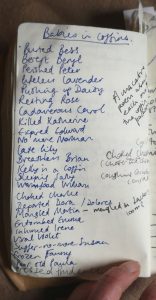
But it got us thinking… perhaps we should include Kelly in the show? Perhaps we should make a new version for the show!? A flurry of frenzied scribbling on black boards gave rise to the following chums that might have appeared in a ‘wider range’:
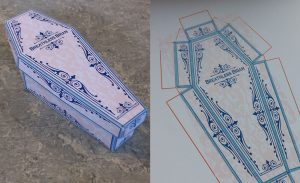
I began to design to the box while Daisy set about honing her skills at tempering white chocolate. The first Coffin design was pretty, but Daisy felt that the coffin lid should feature a porthole window to enable the customer to see the Kelly inside, or ‘Breathless Brian’ as the prototype was.
The idea for this came from the equally bizarre Victorian trinket of the Frozen Charlotte, a diminutive porcelain doll presented in a windowed coffin much like darling Kelly.
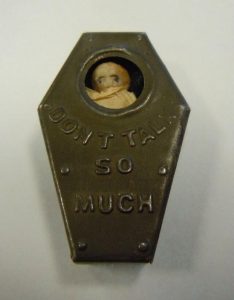
WTactualF!!? Seriously what is wrong with these people!? Well if you would like to know a little more about Frozen Charlotte, please pop along to this blog page after you finish here for a good insight into that.
Back to our own work, and for the sake of expediency, I’ll save the more conceptual rationale for another post, but essentially we settled on making just one new ‘Kelly in a Coffin’, and this would be that of our very own Little Sidders.
Daisy began by sculpting a little figure in soft Sculpy, an oven-bake clay similar to Fimo. Thankfully not cremated, after cooling, a food safe purple silicone putty was used to create a single mould of his body 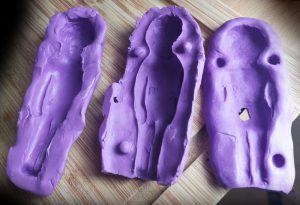 . To be fair, and to give prospective users a warning, this silicone, although food safe and extremely easy to use both hardens quickly, and actually hardens a little much. It is not pliable enough to make a really thin layer, and the thick layers don’t have much give.
. To be fair, and to give prospective users a warning, this silicone, although food safe and extremely easy to use both hardens quickly, and actually hardens a little much. It is not pliable enough to make a really thin layer, and the thick layers don’t have much give.
It did however produce a single damned-fine Sidney, which was then hand painted using food safe powder pigment, blue eyes and a little rouge on the lips and pink tint on the cheeks. Beautiful.
Also, for the chocolate sidders to feature in the show we would need at least one per show. And spares in case of accidents.
We upped the game and daisy then used the single purple mould to make more inedible plaster Sidneys. A quick internet-shopping montage later while the plaster Sidneys were setting and suddenly Daisy was able to make a whole white silicone (again food safe) slab of sidney moulds. ![]()
Now work could begin in earnest.
Well… you know what’d be really nice? If we could offer these for sale to the audience as souvenirs? For other reasons I shall not divulge just here, this idea is on much firmer ground within the context of the show than mere ‘merch’.
Great. So… now we need to make dozens of them? Oh, 100 or so?… Okay… Not a problem! Well… except for the massive problem that slight changes in atmospheric temperature, and even ambient moisture, will ruin chocolate tempering. ‘Tempering’ for those that don’t know is a process by which chocolate is made hard and brittle so that it has a lovely satisfying snap, and a glassy sheen without bloom. It doesn’t however change the taste. If you have ever opened a chocolate bar that has re hardened following an afternoon in the sun and it suddenly looks like it has some kind of chocopox, it hasn’t, it has just lost its temper and is perfectly edible.
Back to the Sidneys: Because, well, ‘science’, it is very hard to temper chocolate in small quantities, there being too much temperature fluctuation and so, tempering chocolate requires 1) a sizable quantity of chocolate, and 2) a great deal of patience.
As Daisy began to temper vats of white chocolate, temperatures in the kitchen would rise, and the tempering would be become harder, so windows would need opening. All the way. Allowing in moisture from the rain, (my gawd, its STILL RAINING!!!) further destabilizing the tempering.
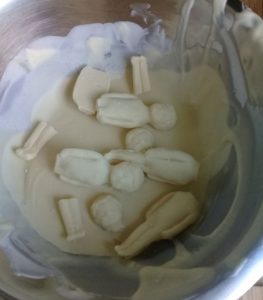
To begin with Daisy was having a success rate of one chocolate Sidney per two batches. That means tempering and carefully filling the six sidneys in the slab, waiting for it to set, removing them. usually in pieces, cleaning the slab, and heating up the chocolate again. 1 in 12 worked. As the chocolate lost its temper so did gentle Daisy. Tears were shed, utensils were broken, names were called. This is clearly not an effective business model with it taking in the region of an hour to make a single Sidney…
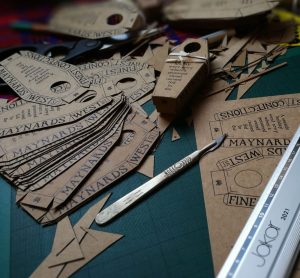
Meanwhile in the other room, having designed and now printed some 100 odd coffins I began to cut them out, base and lids. Then each part was scored and folded before being glued. Now for some figures. Indulge me here because I have to share the mind numbing strangeness that accompanied this task. Each base and lid requires 53 cuts, 24 scored lines and 12 glued tabs. And this needed to be done for, in the first instance, 70 coffins. So that is 3710 cuts, 1680 scores and 840 glued tabs. I vowed not to do it ever again. I broke that vow, but we did enlist friends which lightened the load for a further round of production.
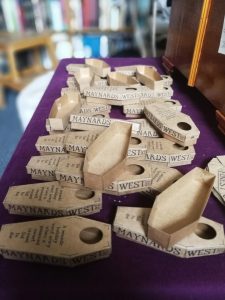
Meanwhile back in the kitchen (for the sake of the writing I am making this all happen on the same day. But this was actually months of work)… Daisy is persistent, even in the face of this utter insanity and eventually the Sidneys started coming out looking, well, as delicious as an effigy of a dead child can look. Soon the tiny bodies started to pile up, metaphorically at least, because they were actually placed with extreme care on tinfoil in a specially sanitized large tupperware… um… morgue? Yeah, for a a couple of weeks now we have been supporting a chilled mortuary for miniature chocolate clones of the same historical person Sidney Barker.
And there it is, the bitter taste the sugar masks… the name: Sidney Barker, and we are reminded of its origin. Rest In Peace little Sidney.
– Ulysses Black
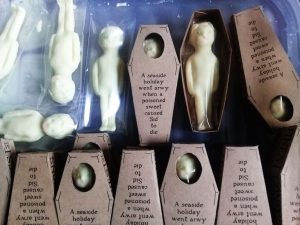
–
SURGERY FOR SIDDERS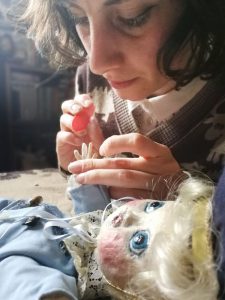
Such an angelic chap our ‘little Sidders’. Perhaps not used to the rough’n tumble life of the stage, he has sustained a minor injury and is need of some medical attention for a broken finger. The finger is now sadly missing and possibly in the belly of a cat. Thankfully every surgeons friend, Milliput –Superfine white -, comes to hand. In this case, the hand of the surgeon Daisy Jordan, as she attends to the ever-so-brave Sidney Barker. She is hoping that a lesson has been learnt, he is hoping that he’ll get a nice big lollipop for being good. His glazed discus eyes betray not the power of anesthetic – none used – but a sugar delirium that engulfs Sidders, for this little chap has a distinct case of the sweet tooth. Perhaps that should be sweet teeth –two of which can be glimpsed peeking through between his cherubic lips.
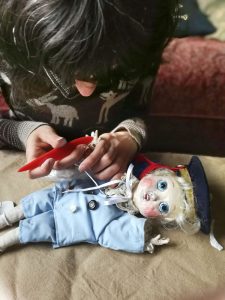
Unfortunately for the historical Sidney Barker, some minor surgery was insufficient to quell his ailment. Maybe a little poor taste to call Sidders angelic, for the real Sidney Barker was destined to meet the angels prematurely.
How did we end up here? Only days before the show and making these little repairs are only part of the pre-Fringe build up. Join us within this blog as puppeteer and artist Daisy Jordan and myself, Ulysses Black, hope to share insight into the sanity-defying world of fringe puppetry, and our complete, half-crazed immersion within the world of Victorian Brighton.
– Ulysses Black.
Introduction

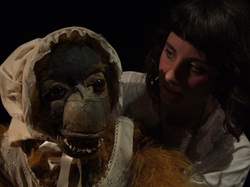
We are delighted to welcome Ulysses Black and Daisy Jordan from Barely Human Puppets as guest bloggers for FringeReview.
The Sorrowful Tale of Sleeping Sidney comes to Brighton Fringe 2018 – “A grotesque, darkly comic Victorian story of obsessive love, murder, and confectionery. Seven lavish glove-puppets and one narrator-puppeteer bring you this tale inspired by the real Brighton Chocolate Cream Poisoner of 1871: sugary, but certainly not sweet!”
















